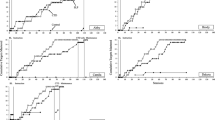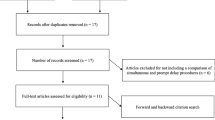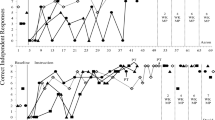Abstract
A review of 22 empirical studies examining the use of constant (CTD) and progressive (PTD) time delay procedures employed with children with autism frames an indirect analysis of the demographic, procedural, methodological, and outcome parameters of existing research. None of the previous manuscripts compared the two response prompting procedures. This review suggests that the effectiveness of the two procedures is similar on some variables. However, the CTD procedure resulted in more errors to criterion, a greater magnitude of procedural modifications, and in a delayed moment of transfer of stimulus control than in the PTD studies. Conclusions may influence clinical and educational practices and indicate a need for research.
Similar content being viewed by others
References
*References marked with an asterisk indicate studies included in the analysis.
American Psychiatric Association. (2000). Autistic disorder. In Diagnostic and statistical manual of mental disorders, (4th ed., text revision, (pp. 69–75)). Washington, DC: Author.
Ault, M. J., Gast, D. L., & Wolery, M. (1988). Comparison of progressive and constant time delay procedures in teaching community-sign word reading. American Journal of Mental Retardation, 93, 44–56.
*Ault, M. J., Wolery, M., Gast, D. L., Doyle, P. M., & Eizenstat, V. (1988). Comparison of response prompting procedures in teaching numeral identification to autistic participants. Journal of Autism and Developmental Disorders, 18, 627–636.
Bennett, D. L., Gast, D. L., Wolery, M., & Schuster, J. (1986). Time delay and system of least prompts: A comparison in teaching manual sign production. Education and Training of the Mentally Retarded, 21, 117–129.
Bodfish, J. W., Symons, F. J., Parker, D. E., & Lewis, M. H. (2000). Varieties of repetitive behavior in autism: Comparisons to mental retardation. Journal of Autism and Developmental Disorders, 30, 237–243.
Bristol, M. M., Cohen, D. J., Costello, E. J., Denkla, M., Eckberg, T. J., Kallen, R., et al. (1996). State of the science in autism: Report to the National Institutes of Health. Journal of Autism and Developmetal Disorders, 26, 121–154.
Buschbacher, P. W., & Fox, L. (2003). Understanding and intervening with challenging behavior of young children with Autism Spectrum Disorder. Language, Speech, and Hearing Services in Schools, 34, 217–227.
Campbell, J. M., Morgan, S. B., & Neighbors, J. W. (2004). Autism spectrum disorders and mental retardation. In R. T. Brown (Ed.), Handbook of pediatric psychology in school settings. Mahwah, NJ: Lawrence Erlbaum.
*Charlop, M. H., Schreibman, L., & Thibodeau, M. G. (1985). Increasing spontaneous verbal responding in autistic children using a time delay procedure. Journal of Applied Behavior Analysis, 18, 155–166.
*Charlop, M. H., & Trasowech, J. E. (1991). Increasing autistic children’s daily spontaneous speech. Journal of Applied Behavior Analysis, 24, 747–761.
*Charlop, M. H., & Walsh, M. E. (1986). Increasing autistic children’s spontaneous verbalizations of affection: An assessment of time delay and peer modeling procedures. Journal of Applied Behavior Analysis, 19, 307–314.
Cohen, D. J., & Volkmar, F. R. (1997). Handbook of autism and developmental disorders. New York: John Wiley & Sons, Inc.
Dawson, G., Toth, G., Abbott, R., Osterling, J., Munson, J., Estes, A., & Liaw, J. (2004). Early social attention impairments in autism: Social orienting, joint attention, and attention to distress. Developmental Psychology, 40, 271–183.
*Dipipi, C. M., Jitendra, A. K., & Miller, J. A. (2001). Reducing repetitive speech: Effects of strategy instruction. Preventing School Failure, 45, 177–181.
Gast, D. L., Wolery, M., Ault, M. J., Doyle, P. M., & Alig, C. (1988). How to use time delay. Comparison of Instructional Strategies Project. Unpublished manuscript, University of Kentucky.
*Gardill, M. C., & Browder, D. M. (1995). Teaching stimulus classes to encourage independent purchasing by students with severe behavior disorders. Education and Training in Mental Retardation and Developmental Disabilities, 254–264.
*Godby, S., Gast, D. L., & Wolery, M. (1987). A comparison of time delay and system of least prompts in teaching object identification. Research in Developmental Disabilities, 8, 283–306.
Handen, B. L., & Zane, T. (1987). Delayed prompting: A review of procedural variations and results. Research in Developmental Disabilities, 8, 307–330.
*Heckaman, K. A., Alber, S., Hooper, S., & Heward, W. L. (1998). A comparison of least-to-most prompts and progressive time delay on the disruptive behavior of students with autism. Journal of Behavioral Education, 8, 171–201.
*Hughes, M. V., Schuster, J. W., & Nelson, C. M. (1993). The acquisition of independent dressing skills by students with multiple disabilities. Journal of Developmental and Physical Disabilities, 5, 233–295.
*Ingenmey, R., & Houten, R. V. (1991). Using time delay to promote spontaneous speech in an autistic child. Journal of Applied Behavior Analysis, 24, 591–596.
Kabot, S., Masi, W., & Segal, M. (2003). Advances in the diagnosis and treatment of autism spectrum disorders. Professional Psychology: Research and Practice, 34, 26–33.
Kanner, L. (1943). Autistic disturbances of affective contact. Nervous Child, 2, 217–250.
Keel, M. C., & Gast, D. L. (1992). Small-group instruction for students with learning disabilities: Observational and incidental teaching. Exceptional Children, 58(4), 1–12.
*Johnston, S., Nelson, C., Evans, J., & Palazolo, K. (2003). The use of visual supports in teaching young children with Autism Spectrum Disorder to initiate interactions. Augmentative and Alternative Communication, 19, 86–103.
*Leung, J. P. (1994). Teaching spontaneous requests to children with autism using a time delay procedure with multi-component toys. Journal of Behavioral Education, 4, 21–31.
*Matson, J. L., Sevin, J. A., Box, M. L., Francis, K. L., & Sevin, B. M. (1993). An evaluation of two methods for increasing self-initiated verbalizations in autistic children. Journal of Applied Behavior Analysis, 26, 389–398.
*Matson, J. L., Sevin, J. A, Fridley, D., & Love, S. R. (1990). Increasing spontaneous language in three autistic children. Journal of Applied Behavior Analysis, 23, 227–233.
*Morse, T. E., & Schuster, J. W. (2000). Teaching elementary students with moderate intellectual disabilities how to shop for groceries. Exceptional Children, 66, 273–288.
Morse, T. E., & Schuster, J. W. (2004). Simultaneous prompting: A review of the literature. Education and Training in Developmental Disabilities, 39(2), 153–168.
National Research Council. (2001). Educating children with autism. Washington, DC: National Academy Press.
*Nientimp, E. G., & Cole, C. L. (1992). Teaching socially valid social interaction responses to students with severe disabilities in an integrated school setting. Journal of School Psychology, 30, 343–354.
*Norman, J. M., Collins, B. C., & Schuster, J. W. (2001). Using an instructional package including video technology to teach self-help skills to elementary students with mental disabilities. Journal of Special Education Technology, 16(3), 5–18.
Ozonoff, S. (1998). Assessment and remediation of executive dysfunction in autism and Asperger Syndrome. In E. Schopler, G. B. Mesibov, & L. Kunce (Eds.), Asperger Syndrome and high functioning autism. Plenum Press.
Ritvo, E. R., & Freeman, B. J. (1977). National society for autistic children definition of the syndrome of autism. Journal of Pediatric Psychology, 2, 146–148.
Schuster, J. W., Gast, D. L., Wolery, M., & Guiltinan, S. (1988). The effectiveness of a constant time-delay procedure to teach chained responses to adolescents with mental retardation. Journal of Applied Behavior Analysis, 21, 169–178.
Schuster, J. W., Morse, T. E., Ault, M. J., Doyle, P. M., Crawford, M. R., & Wolery, M. (1998). Constant time delay with chained tasks: A review of the literature. Education and Treatment of Children, 21, 74–107.
Tawney, J. W., & Gast, D. L. (1984). Single participant research in special education. Columbus, OH: Charles Merill.
*Taylor, B. A., & Harris, S. L. (1995). Teaching children with autism to seek information: Acquisition of novel information and generalization of responding. Journal of Applied Behavior Analysis, 28, 3–14.
Touchette, P. E. (1971). Transfer of stimulus control: Measuring the moment of transfer. Journal of Experimental Analysis of Behavior, 15, 347–354.
*Venn, M. L., Wolery, M., Werts, M. G., Morris, L. D., DeCesare, L. D., & Cuffs, M. S. (1993). Embedding instruction in art activities to teach preschoolers with disabilities to imitate their peers. Early Childhood Research Quarterly, 8, 277–294.
*Wall, M. E. & Gast, D. L. (1997). Caregivers’ use of constant time delay to teach leisure skills to adolescents or young adults with moderate or severe intellectual disabilities. Education and Training in Mental Retardation and Developmental Disabilities, 340–356.
*Wall, M. E., Gast, D. L., & Royston, P. A. (1999). Leisure skills instruction for adolescents with severe and profound developmental disabilities. Journal of Developmental and Physical Disabilities, 11, 193–219.
Wing, L., & Potter, D. (2002). The epidemiology of autism spectrum disorders: Is the prevalence rising? Mental Retardation and Developmental Disabilities, 8, 151–161.
*Winterling, V., Gast, D. L., Wolery, M., & Farmer, J. A. (1992). Teaching safety skills to high school students with moderate disabilities. Journal of Applied Behavior Analysis, 25, 217–227.
Wolery, M., Ault, M., & Doyle, P. M. (1992). Teaching students with moderate to severe disabilities: Use of response prompting strategies. White Plains, NY: Longman Publishing Group.
*Wolery, M., Gast, D. L., Kirk, K., & Schuster, J. (1988). Fading extra-stimulus prompts with autistic children using time delay. Education and Treatment of Children, 11, 29–44.
Wolery, M., Holcombe, A., Cybriwsky, C., Doyle, P. M., Schuster, J. W., Ault, M. J., et al. (1992). Constant time delay with discrete responses: A review of effectiveness and demographic, procedural, and methodological parameters. Research Developmental Disabilities, 13, 239–266.
Wolery, M, & Schuster, J. W. (1997). Instructional methods with students who have significant disabilities. Journal of Special Education, 31, 61–79.
World Health Organization (WHO). (1993). The ICD-10 classification of mental and behavioural disorders: Diagnostic criteria for research. Geneva: Author.
Acknowledgments
The author gives special thanks to Dr. David L. Gast, Dr. Karen Braxley, Dr. David R. Walker, and Dr. John Matson, as well as the reviewers of the Journal of Autism and Developmental Disorders for their insight and suggestions regarding this manuscript. The results of this review were summarized and presented at the Georgia Council for Exceptional Children Conference in January, 2006.
Author information
Authors and Affiliations
Corresponding author
Rights and permissions
About this article
Cite this article
Walker, G. Constant and Progressive Time Delay Procedures for Teaching Children with Autism: A Literature Review. J Autism Dev Disord 38, 261–275 (2008). https://doi.org/10.1007/s10803-007-0390-4
Received:
Accepted:
Published:
Issue Date:
DOI: https://doi.org/10.1007/s10803-007-0390-4




